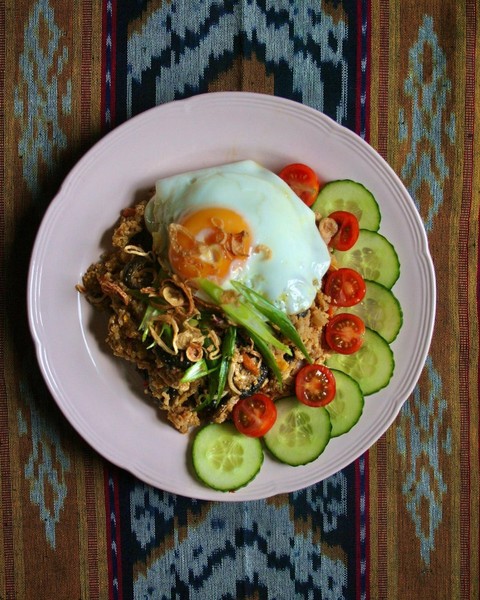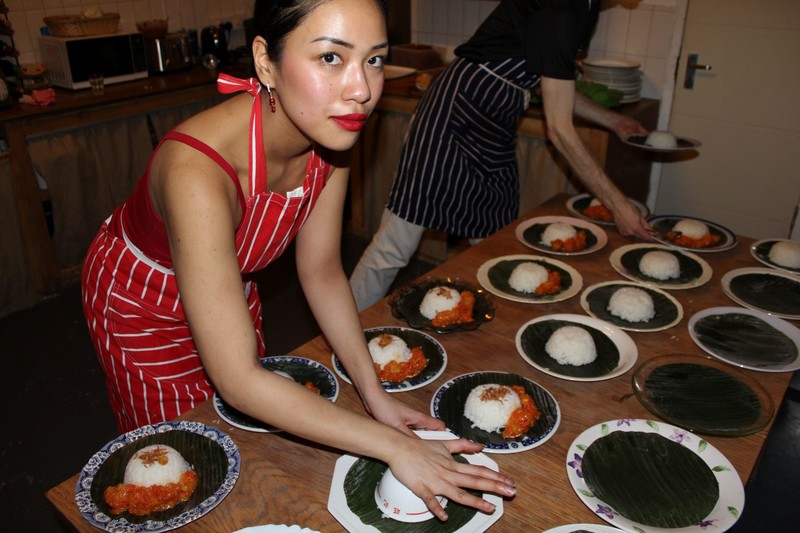She also features on our sister title CODE's 30 under 30 list for 2022/23.
I noticed there were problems with the assimilation of many Asian cuisines in UK food culture immediately upon moving to London from Indonesia. Indonesian cuisine was almost non-existent in London, and at the time of writing, there are still only a handful of Indonesian food establishments in the city.
Migration to Europe from Indonesia has historically been negligible compared to other East and Southeast Asian populations, and so the cuisine, ingredients and chefs haven’t set up all that many businesses or created a significant market. The exception in Europe is the Netherlands, a former colonial ruler of Indonesia, which has enjoyed an established Indonesian food culture for many decades. But hop over the Dutch border to Germany or Belgium and you’ll struggle to find a single rambutan, pandan leaf or bakwan. There must be room here for cuisine from one of the world’s biggest countries?
Looking wider at Asian food’s presence in the city, the lack of regional restaurants also surprised me. I would notice how many venues serve pan-Asian menus, with satay in Thai restaurants, gyoza in Chinese ones, tempura in Vietnamese places and so on.
I began thinking: adapting menus to meet the expectations of a Western audience (aka the chicken tikka masala phenomenon) may feel convenient, effective and harmless in the short term. But it becomes a wider issue due to the misrepresentation that it encourages - it leads to the erasure of the original culture and traditions. That satay in a Thai restaurant dilutes much of the cultural connection that the dish has from its origin in Indonesia.
Of course, this is in no way an insult to the hardworking Asian food entrepreneurs of the UK, many of whom were first-generation immigrants using their food culture to establish themselves and their businesses in a new country, where other jobs were hard to come by. It is wider cultural expectations that lead to this disconnect. We should aspire as an industry to balance the delicate equilibrium of providing genuineness and context with the necessity of supplying demand. It's about having conversations.
Still, defining 'what is Indonesian food?' is always challenging for me. Where would I even start? With over seventeen thousand islands, the breadth of diversity in the world’s largest archipelago is mindblowing and this is naturally reflected in the nation’s cuisine. From this ocean of variety, how have Western menus found just three dishes: the rightly much-loved nasi goreng, gado-gado, and satay? What has caused this culinary glass ceiling?
Pino Edward, of Pino’s Warung (one of only two Indonesian restaurants I regularly frequent in London), acknowledges this skewed perception of Indonesian cuisine and highlights our responsibility as Indonesians to broaden it. “There’s so much more to our cuisine,” he says. “As Indonesians, we need to introduce more of our dishes from other islands. If not us, then who?”
The renowned Indonesian chef and food writer Petty Elliott elaborates on the same frustration: 'Indonesian cuisine is completely under-represented. It is quite shocking that as the fourth largest country in the world, as the home to nutmeg and cloves and as the centre of the spice trade centuries ago, Indonesian food is hardly known. The people in the world just have no knowledge about regional Indonesian food and Indonesia as a country.'
Like Edward, Elliott is a believer in our role as individuals as part of the Indonesian diaspora in raising awareness. 'Each of us has a duty to inform and show our non-Indonesian friends just how diverse our cuisine is,' she explains.

I have noticed over the years is that existing representations of Indonesian cuisine tend to be wildly inaccurate. Supermarket branded ‘Indian-Inspired rendang paste’ (offensive to not just one, but two cultures!) and ready-made ‘pork and leek nasi goreng’ (both headline ingredients are hardly ever found in the dish) are unfortunate examples. 'They’re just wrong.' Edward laughs.
In Indonesian, the word 'satay' merely refers to any skewered dish. On the British high street, you’ll find it reincarnated in the form of ‘satay rice box’, ‘satay salad’ and - quite impossibly, as I have tried skewering a liquid - ‘satay marinade’, all with no skewer in sight. The misconception is the equation of ‘satay’ with ‘peanut sauce’. The Jakarta Post counted 252 unique sate (the original Indonesian spelling) varieties in Indonesia, so why has but the humble peanut version stuck in the UK?
Our peanut problem extends to Indonesia’s favourite salad. It is often wrongly assumed that gado-gado is any salad dressed in peanut sauce. Dish defining differences - whether vegetables are cooked, the make-up of the spices in the dressing, the use of coconut milk - are ignored, and therefore dishes such as karedok, lotek, and pecel are too. Once again, the breadth of Indonesia’s cuisine is overlooked.
And then there’s the ‘tempe’ problem. Before attaining prominence in the UK’s health food stores, I regularly received looks of repulse when explaining how tempe (again, my preferred spelling, as opposed to the Westernised ‘tempeh’) is made from fermented soy beans. Over the years, I observed the growing popularity and Westernisation of it as a 'superfood' and meat substitute. Its humble roots are far from this: it was eaten by those who were not able to afford meat as a cheap source of protein, and its creation from a traditional zero-waste culture was more from necessity than choice. Quite a contrast to its current mainstream incarnation.
On spelling, Prinka Saraswati, the author of the educational Indonesian food newsletter Dapur Saraswati, makes the argument: 'If ‘resume’ isn’t spelled ‘resumay’ and sake isn’t spelled sakeh, why does ‘tempe’ need to be spelled ‘tempeh’?'
It just so happens that two of the most respected Indonesian food personalities reside in the UK: Sri Owen, the celebrated author of the first Indonesian cookbook written in the English language; and the aforementioned Petty Elliott. Despite their skills, experience and talent, all widely recognised in Indonesia, why are they not appreciated here in the same way other global food figures are?
'Moving to the UK was challenging for many reasons.' Elliott admits. 'With so little known about Indonesian food in the UK, a very small Indonesian diaspora and only very few Indonesian food writers and chefs, it has been challenging.'
Elliott’s first UK published cookbook is due to be launched in spring 2023, having taken almost four years to secure despite impressive credentials and a track record of successful publications in her home country. In the meantime, I would regularly encounter published writing on Indonesian cuisine, such as often inauthentic recipes in major online publications by non-Indonesian authors. Without a platform for Indonesian voices, it is no surprise that the food has not grown to reach its full potential in the UK and beyond.
Over the years I have felt frustrated, and perhaps angry, at these issues. Positively, though, it has been one source of motivation to contribute where I can - to reclaim the respect Indonesian cuisine deserves. Today, I’m more enthusiastic than ever to celebrate my country’s food and culture. I am not against contemporary reinterpretations of tradition, but I do feel some appropriation of foods, without any attention given to the history and origins, can be disrespectful.
My hope for the Indonesian food scene in the UK is to celebrate true portrayals of Indonesians, be it in the restaurant sector or in media coverage. I’m a strong believer in the importance of real representation of the food that comes from marginalised communities. I’m passionate about collaborating specifically with other Indonesians in the UK as it not only emboldens the Indonesian reputation here as a whole, but mutually builds individual strength. Moreover, the more diverse the demographic of Indonesian people involved, the more nuanced and multifaceted the representation of our heritage becomes.
Through Spoons, my plant-based Indonesian supper club series, I’ve worked with the likes of Elliott and Edward, and I have seen the growing interest and demand for Indonesian food. It’s clear our cuisine deserves its big moment. It’s about time - and it’s coming.

Recommendations:
Pino’s Warung: a piece of Indonesian ‘warung’ culture in London’s Camden Market, Pino cooks up some authentic streetside and home-cooked classics.
Triple Hot Spicy: Located in Queensway, this small eatery transports you to a humble Jakarta shopping centre, serving up authentic and unforgivingly Indonesian dishes - bakso and soto are highlights.
Bali Bali: Unpretentious Indonesian restaurant in London’s West End with a reasonably extensive menu of Indonesian classics. Worth a try if you’re in the area or as an introduction to Indonesian cuisine for those less familiar to it.
- Rahel Stephanie








